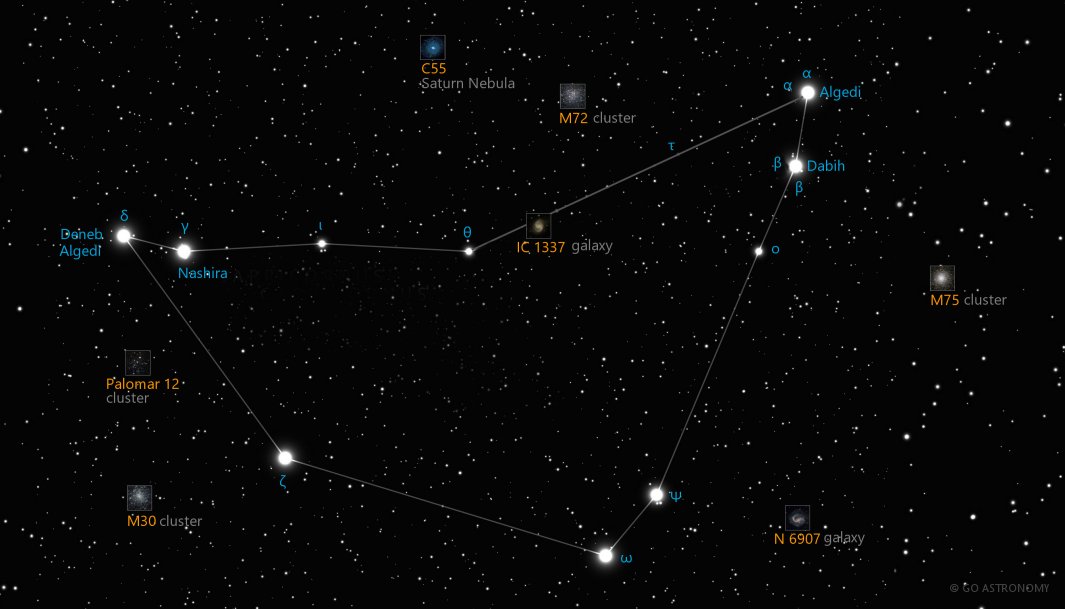Capricornus, the Goat (Cap)
(CAP-rih-CORN-us)
The Southern constellation of Capricornus, the Goat, is best viewed in Fall during the month of September.
Capricornus is the 40th largest constellation. It's brightest star is Deneb Algedi at magnitude 2.85. The boundary of the Capricornus constellation contains 8 stars that host known exoplanets.
- Pronunciation:
- CAP-rih-CORN-us
- Meaning:
- Goat
- Genitive:
- Capricorni
- Abbreviation:
- Cap
- Constellation Family:
- Zodiacal
- Hemisphere:
- Southern
- Quadrant:
- SQ4
- Visibility:
- 60° N - 90° S
- Best viewing month*:
- September
- Area:
- 414 sq. degrees
- Size:
- 40th largest
- Right Ascension (avg):
- 21h 3m
- Declination (avg):
- -18°
- Brightest star:
- Deneb Algedi (2.85)
- Stars with planets:
- 8
- Caldwell objects:
- |
Brightest Stars in Capricornus
The 10 brightest stars in the constellation Capricornus by magnitude.
- Star
- Magnitude
- Spectral class
- Delta Capricorni (δ Cap)
- 2.85
- A5mF2 (IV)
- Beta Capricorni (β1 Cap)
- 3.05
- A5:n
- Alpha Capricorni (α2 Cap)
- 3.58
- G6/G8III
- Gamma Capricorni (γ Cap)
- 3.69
- A7III:mp
- Zeta Capricorni (ζ Cap)
- 3.77
- G4Ibp
- Theta Capricorni (θ Cap)
- 4.08
- A1V
- Omega Capricorni (ω Cap)
- 4.12
- K4III
- Psi Capricorni (ψ Cap)
- 4.13
- F5V
- Iota Capricorni (ι Cap)
- 4.27
- G8III
- Alpha Capricorni (α1 Cap)
- 4.3
- G3Ib
Double Stars in Capricornus
These are the brightest and easiest-to-find double, triple, and quadruple star systems in the constellation Capricornus. Also see all star clusters.
- Star system
- Magnitudes
- Type
- Alpha Capricornus
- 3.7, 4.3
- double
- Beta Capricornus
- 3.2, 6.1
- double
Star Clusters in Capricornus
The most notable and easy-to-find star clusters in the constellation Capricornus . Also see all star clusters.
Galaxies in Capricornus
The most notable galaxies in the constellation Capricornus. Also see all galaxies.
The Sea-Goat of the Sky
Capricornus, commonly referred to as 'the Sea-Goat', is one of the 12 zodiac constellations identified by early astronomers. Known for its unique symbolism and association with the mythological creature that is half goat, half fish, Capricornus is a constellation that has intrigued stargazers and astronomers alike for centuries.
Historical Overview
Capricornus is one of the 88 modern constellations and was also among the 48 constellations listed by the 2nd-century astronomer Ptolemy. Its name translates to 'horned goat' or 'goat horn' in Latin, but it is more commonly referred to as the 'Sea-Goat'. This odd creature is part of ancient mythologies, including the Babylonians and Greeks, where the god Pan transformed into a sea-goat to escape the monster Typhon.
Location and Notable Features
Capricornus is located in the fourth quadrant of the southern hemisphere (SQ4) and can be seen at latitudes between +60? and -90?. The constellation is surrounded by Aquila, Sagittarius, Microscopium, Piscis Austrinus, and Aquarius.
Capricornus is not particularly bright, with its brightest star, Deneb Algedi (or Delta Capricorni), having an apparent magnitude of only 2.81. Deneb Algedi is a binary star system about 39 light-years away. Despite the constellation's relative faintness, its larger size and distinct, albeit faint, pattern make it fairly easy to identify in a dark sky.
Deep Sky Objects
While not abundant in bright stars, Capricornus is home to several notable deep-sky objects. Among these is Messier 30 (M30), a dense globular cluster located about 27,000 light-years away. Discovered by Charles Messier in the 18th century, M30 is a spectacular cluster of stars that is nearly as old as the universe itself. It is best observed through a medium-sized telescope.
Another fascinating object within Capricornus is the galaxy group HCG 87, a compact group of galaxies that includes a spiral, an elliptical and an edge-on spiral galaxy. It is a challenging target for amateur astronomers, requiring large telescopes and dark skies.
Observing Capricornus
For observers in the northern hemisphere, Capricornus is best viewed in the summer and early fall months, when it is highest in the sky. Despite its relatively faint stars, the constellation's large size and unique kite-like shape make it identifiable. Observers should first locate the "Summer Triangle" formed by the bright stars Deneb, Vega, and Altair. From there, look southward to find Capricornus.
To view the constellation's deep-sky objects, such as M30 and HCG 87, you'll need a medium to large telescope and a dark sky, free from light pollution.
* Constellation shown for northen hemisphere skies. For the southern hemisphere, constellations appear rotated 180 degrees (upside-down and left-right reversed) from what is shown. Remember that seasons are reversed too - summer in northern latitudes is winter in southern latitudes.
** Circumpolar constellations are visible year-round in the hemisphere listed (and not at all in the opposite hemisphere).





